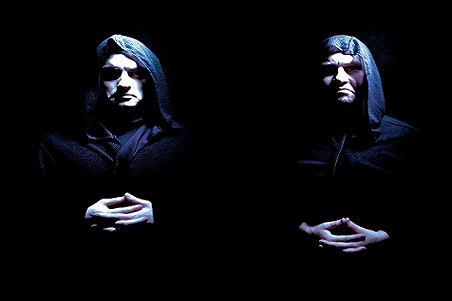Satan, the occult, death, space, Tolkien, and even Jesus are frequently used influences within extreme metal. Given the pedigree of Star Wars, it’s a wonder why more metal bands aren’t citing the works of George Lucas more often. Every once in a while, there is a song to be heard (Fear My Thoughts’ “Tie Fighting” comes to mind), but bands completely focused on “the trilogy” are practically unheard of.
Enter Hoth, a mysterious entity from the lands of Washington. Composed of members Eric and David, this two-piece has crafted a perfect union of blackened melodic death metal and Star Wars. 2012 introduced the world to Infinite Darkness, an album full of brutal Star Wars imagery and catchy riffs. Certainly an album to add to the collection of any Star Wars fan, even if a few of the concepts lacked focus.
Bringing us up to the present time, the release of the band’s second offering, Oathbreaker, is nearly here. A conceptual album, “about an individual from his conception and follows him down a path that grows darker and darker,” sets the stage for another bout of melodic black/death metal that stands head and shoulders above its predecessor. DR was lucky enough to catch up with these Sith metallers to get the low down on writing a concept album, the influence of Star Wars, and more.
Dead Rhetoric: Many bands reference Tolkien, what made you guys decide to use Star Wars as a direct influence?
Hoth: In the beginning, this is back several years ago now, we were talking about all the creatures in the Star Wars galaxy: the space slug in the asteroid, the monster in the trash compactor in the Death Star, the clawed rancor, the yeti-like wampa, the sarlacc pit, which is just a giant teethed maw in the sand, and so on. These creatures, just by their description were completely horrifying and brutal, and thus made for the perfect lyrical content of extreme metal songs. And as far as we could tell, it is not something that people had really explored that much musically.
Beyond the fearsome creatures, there are so many universal themes and timeless motifs present in the Star Wars stories. The original trilogy is basically just the hero’s journey in Space Opera form. This same story found with the same stock characters can be found throughout the mythologies of numerous cultures. For more info on that check out the book The Hero with a Thousand Faces by Joseph Campbell. By exploring the themes present in Star Wars we explore themes present in our own human history and we tackle questions and philosophies that have been debated for centuries.
Dead Rhetoric: What are some of your influences outside of Star Wars?
Hoth: We both enjoy fantasy and science fiction. We enjoy stories that evoke a strong emotional response. We are also into a lot of black metal (Windir, Thulcandra, Dissection, Kampfar to name a few). Sometimes we look to great song-writers who are good at crafting narratives through their music and composition. Some bands are just incredible that doing that; ones that come to mind right now are Moonsorrow, Opeth, Agalloch, and Wintersun. For a musician, composing a song that is powerful and thoughtful should be very important. Every song should tell a story, and not just through the lyrics, but through the music itself. Outside of metal, we also look to classical composers, particularly from the Romantic era, whom we find to be ‘metal.’ These composers are also masters at writing music in the narrative sense that we described above. Some of our favorites are Beethoven, Mahler, Wagner, and Dvorak. Sometimes you just listen to a classical piece and you think, “Holy shit this is so metal.” (Check out Mahler’s 5th Symphony in C minor, for example.)
Dead Rhetoric: It seems that the Star Wars universe is ripe for the picking with metal. Out of all of the potential names, why choose Hoth?
Hoth: Hoth was initially chosen because Hoth is the most grim and frostbitten planet in the galaxy, of course. It is also short and sweet and sounds nice when you say it aloud. Additionally, and not many people know this, Hoth is a figure in Norse mythology. According to legend, he was tricked by Loki into slaying his own brother, Baldr. This is an interesting reflection of some of the themes of Oathbreaker: corruption by an evil force, betrayal of those once held dear, damnation, etc.
Dead Rhetoric: What was the thought process that came with shaping and designing your logo?
Hoth: We love our logo! An artist, Daniel Suter, designed the original logo for us a couple years ago. We then took his design and cleaned it up a little bit to make it slightly more legible. It definitely works well as a metal band logo, and some people even claim it resembles a TIE Fighter. Daniel Suter’s artwork can be found here: https://www.facebook.com/ArtoftheWindigo. If you have Instagram, he posts art pretty regularly at @thewindigo.
Dead Rhetoric: Anything you care to share about the conception of your cold, icy artwork for Oathbreaker?
Hoth: When we commissioned the album artwork to be done by artist Dusty Peterson, we pretty much gave him free reign over what to specifically paint and only gave him a few themes and feelings to go off of. We told him we wanted to something that made the viewer feel cold while gazing upon it. We wanted it to look lonely and forlorn and we wanted a sort of surreal image that reflected the emotions and themes of the album. After hearing that and supplying a few Oathbreaker demo tracks, Dusty did all the rest and did an absolutely amazing job. If you want to check out more of Dusty’s amazing artwork, you can find it at http://dustypeterson.net.


